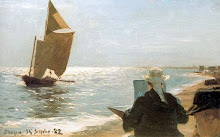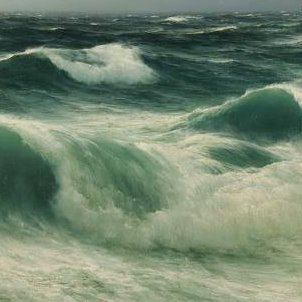Occasionally it's worth breaking the 'oils only' theme of this blog to look at some watercolours. These watercolours by the French illustrator Edmund Dulac are for Shakespeare's marine-themed play The Tempest. Watercolour is great for creating nebulous, marbled or bleeding effects to add texture and mystery, especially in backrounds. Similar effects can be achieved with oil paint highly diluted with a solvent such as turpentine or mineral spirit. But beware of the health hazards of breathing solvent fumes. Open windows and use a fan to disperse the fumes, or work outdoors in a breeze. Paint drips are fashionable in contemporary painting, but if you want to avoid them, keep the canvas horizontal when using diluted paint.
Cherry Hood, an Australian artist who won the country's most prestigious portrait prize a few years ago, paints with watercolour on large canvases. This avoids the health issues of using solvents but she has to seal the pigment with vanish because there's no glass to protect it. She uses damar varnish, which presumbly would have to be applied as a spray, brushing it on would smear the watercolour. I would guess there are health issues with spraying varnish too, but the process would be fairly quick and you could wear a mask.




































No comments:
Post a Comment